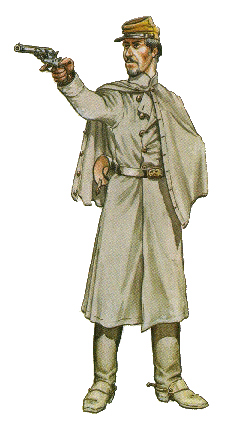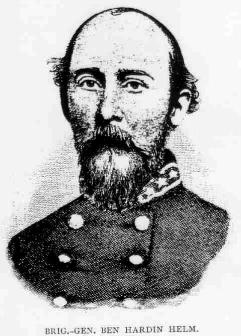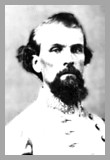|





| |
The
Historical
First Kentucky Cavalry
|

|
"I am always glad to think and write about the gallant old
First Kentucky Cavalry. It was as brave a body of men as any officer had
the good fortune to command. If I sent them into action oftener than I
should have done, it was because I knew they would be equal to any
heroic duty which might be imposed upon them."
Lt. General Joseph Wheeler
Commander of Cavalry, Army of Tennessee
|
PAGE CONTENTS
Highlights
Benjamin Hardin Helm, Commanding Officer
Commanders of the 1st Kentucky Cavalry
Battles of the 1st Kentucky Cavalry
Generals of Cavalry (Under Which the First Served)
Uniforms of the 1st Kentucky Cavalry
Weapons of the 1st Kentucky Cavalry
Horses of the 1st Kentucky Cavalry
Primary Sources for History of the 1st Kentucky Cavalry
HIGHLIGHTS
 It's
first commander, Benjamin Hardin Helm, was the brother-in-law of Union president
Abraham Lincoln. It's
first commander, Benjamin Hardin Helm, was the brother-in-law of Union president
Abraham Lincoln.
 It's
men were the first Kentucky cavalrymen to respond to the call for service
to the Confederate States in 1861 ... It's
men were the first Kentucky cavalrymen to respond to the call for service
to the Confederate States in 1861 ...
 ...
and it served to the very last, as President Jefferson Davis' guard when
he was captured in Georgia in May of 1865. ...
and it served to the very last, as President Jefferson Davis' guard when
he was captured in Georgia in May of 1865.
 Part
of the first cavalry brigade established in the Western theater (with the 8th
Texas cavalry). Part
of the first cavalry brigade established in the Western theater (with the 8th
Texas cavalry).
 Served
under famous cavalry generals Joseph Wheeler and Nathan Bedford Forrest, among
others. Served
under famous cavalry generals Joseph Wheeler and Nathan Bedford Forrest, among
others.
 Was
the first unit to break the Union line in the last great Confederate victory at
Chickamauga, Georgia Was
the first unit to break the Union line in the last great Confederate victory at
Chickamauga, Georgia
 Was
the first unit to cross the field and start the last large battle of the War, at
Bentonville, NC in 1865. Was
the first unit to cross the field and start the last large battle of the War, at
Bentonville, NC in 1865.
 A
member of Kentucky's famous Orphan Brigade, being officially adopted in 1884. A
member of Kentucky's famous Orphan Brigade, being officially adopted in 1884.
Return to Contents at Top
Benjamin Hardin Helm
Original Commander of the
First Kentucky Cavalry, CSA
 |
| General Helm was considered one of the three "beloved" officers
of the First Cavalry (along with Captains Noel and McCauley), all of
whom died in combat with the regiment. Then Major Helm was an
officer in the Federal service prior to the war, and brother-in-law
to U.S. President Abraham Lincoln. Lincoln knew that Helm's heart
lay with the South, and offered to give him a higher position and
assign him to the western territories so that he would not have to
fight against the men of the South. Nonetheless, Helm resigned his
commission and was first commissioned into Confederate service as a
Colonel of cavalry. He formed, trained, and led the First Kentucky
Cavalry into the field before being promoted after the Battle of
Shiloh to general and being transferred to the infantry. Helm found
his greatest fame at the head of Kentucky's Orphan Brigade and died
leading it in a charge at the Battle of Chickamauga. One of his
cavalrymen, temporarily serving with the Orphan Brigade due to a
medical issue, marched into that charge with Gen. Helm, uniting
under his banner for his last action a representative of his first
command. When Gen. Helm's body was removed from Georgia in 1884 to
be reburied in his native Kentucky soil, soldiers from both the
Orphan Brigade and the First Kentucky Cavalry accompanied it on the
journey, and after the burial the infantrymen of the Orphan Brigade
adopted the First Kentucky Cavalry into their ranks. In Heaven, Gen.
Helm must have smiled. |
Return to Contents at Top
Commanders of the First Kentucky Cavalry, CSA
| Col. Benjamin Hardin Helm |
1861-62 |
| Lt. Col. Thomas G. Woodward |
1862 |
| Col. John Adams |
1862 |
| Maj. J. W. Caldwell |
1862 |
| Col. J. Russell Butler |
1862-64 |
| Lt. Col. Jacob Wark Griffith |
1864-65 |
NOTES:
Col. Helm was promoted to be a general of infantry and
was later assigned to command the highly famous Kentucky "Orphan"
Brigade. He was mortally wounded leading them in a charge at the last
great Confederate victory at Chickamauga, Georgia on Sept. 20 and died
with the words, "Victory! Victory!" on his lips.
Col. Adams, a brief and unpopular commander with the 1st
Kentucky, was also later promoted to a general of infantry. He went on
to become one of the five generals killed at the Battle of Franklin
(Tennessee) on Nov. 20, 1864, and died gloriously atop his horse on top
of a Federal parapet, with his hand on the Federal flag staff.
Lt. Col. Griffith was the father of D. W. Griffith,
who later became known as the father of the modern film-making business
and had the most prestigious of Hollywood's award, the Lifetime
Achievement Oscar, named after him before a fit of political correctness
had the name removed because his views of racial issues were
commensurate with the times in which he lived. |
Return to Contents at Top
Mustered into Confederate service on October 28, 1861
The First Kentucky Cavalry's most significant service was in the
Army of Tennessee, the Confederacy's main army fighting in the Western Theater.
Cavalry units served in three unique ways in the war. Some were part of raiding
units, such as those under famous Kentuckian John Hunt Morgan, others served as
the main force holding a certain region, such as those under Nathan Bedford
Forrest, while the third kind served with the large battle armies. The First
Cavalry belonged to this last group, being part of the eyes and ears of the
large army, scouting the way when it was on the advance, serving in the fight
during the battles, and protecting it's rear from the enemy when on retreat. The
fortunes of the First Kentucky, therefore, mirrored those of the Army of
Tennessee, and its predecessors, through most of the war. It was present for
many of the most famous actions, often playing a principal part in them, and
experienced both the joys and agonies of that army as it's fortunes waxed and
waned.
This service was mostly in the Kentucky Cavalry Brigade, under
general of cavalry Joseph Wheeler. The First Kentucky "grew up" with this famous
cavalry general. It was part of his first brigade command, and the first cavalry
brigade of the western army, when it was teamed with the 8th Texas Cavalry in a
small brigade under Wheeler's command. As both Wheeler's fortunes and the size
of the cavalry command grew, the First Kentucky was there for the ride.
Battles and Fights of the First Kentucky Cavalry, CSA
List is incomplete!
| Hewey's Bridge (Tn.) |
May 8, 1862 |
| Sweeden's Cove (Tn.) |
June 4, 1862 |
| Munfordville (Ky.) |
Sept. 17, 1862 |
| Perryville (Ky.) |
Oct. 8,1862 |
| Loudon (Ky.) |
Oct. 1862 |
| Battle of Murfreesboro (Stone's River) |
Dec. 31, 1862 & Jan. 2, 1863 |
| Tullahoma Campaign |
June-July, 1863 |
| Hoover's Gap |
June 24, 1863 |
| Battle of Chickamauga |
Sept. 19-20, 1863 |
| McLemore's Cove |
Sept. 21, 1863 |
| Sequatchie Valley |
Oct. 2, 1863 |
| Missionary Ridge |
Nov. 26, 1863 |
| Ringgold Gap |
Nov. 27, 1863 |
| Charleston, Tn. |
Dec. 28, 1863 |
| Atlanta Campaign (AC) |
May- Sep, 1864 |
| AC: Dug Gap |
May 8, 1864 |
| AC: Resaca |
May 14-15, 1864 |
| AC: Cassville (Ga.) |
May 24, 1864 |
| AC: Peachtree Creek |
July 20, 1864 |
| AC: Stoneman's Raid (SR) |
July-August 1864 |
| AC/SR: Sunshine Church |
July 31, 1864 |
| AC/SR: Jug Tavern (King's Tanyard) |
Aug. 3, 1864 |
| Saltville (Va.) |
Oct. 2, 1864 |
| March to the Sea |
Nov - Dec, 1864 |
| Carolinas Campaign (CC) |
Jan - April 1865 |
| CC: Columbia (SC) |
Feb. 17, 1865 |
| CC: Bentonville (NC) |
March 19-21, 1865 |
| Jefferson Davis Escape |
April - May 1865 |
Return to Contents at Top
Surrendered at Washington, Georgia on May 10, 1865
1 month and 1 day after Robert E. Lee and the Army of Northern Virginia's
surrender
2 weeks after Joseph E. Johnston and the Army of Tennessee's surrender
Very Brief Narrative History of the First Kentucky Cavalry
During the earliest days of the war in the west, as both sides
were beginning to make their moves and muster men into service, a Southern army
began to form around Bowling Green, Kentucky during the summer of 1861. At
various points throughout the Commonwealth of Kentucky, but mostly in the
western and south central portions, men rallying to the Southern cause recruited
groups of men for cavalry service and began moving these groups to the army at
Bowling Green. Benjamin Hardin Helm, brother-in-law of Union President Abraham
Lincoln, had been commissioned as a colonel of cavalry and assigned to Bowling
Green. As these companies of men arrived, he began training them for military
cavalry service. By October enough companies were present to form a regiment of
cavalry and these soldiers were mustered in as the First Kentucky Cavalry. Many
others would follow: 13 more regiments before the war was over, and battalions
and smaller units. But these men were the first.
Famous Generals of Cavalry Under Whom the First Kentucky
Served
Lt. Gen. Joseph Wheeler
Commander of Cavalry,
Army of Tennessee |
 |
|
 |
Lt. Gen. Nathan Bedford Forrest
Commander of Cavalry |
Return to Contents at Top
UNIFORMS OF THE FIRST KENTUCKY CAVALRY
Though the references have been few, in our research some clues have surfaced
concerning the uniforms of the First Cavalry. Currently, we have two references.
| Private, 1st Kentucky
Cavalry Brigade
The picture at right, with the title above, is from Uniforms
of the Civil War, by Philip Haythornthwaite. It is from Plate
39, and is accompanied by the following description below.
|
 |
"39. C.S.A.: ... c) Private, 1st Kentucky Cavalry Brigade
"The Confederate cavalry greatcoat was double-breasted with standing collar and
brass buttons, the cape long enough to reach the cuffs of the coat, the whole
being grey in colour. It is doubtful, however, whether many such overcoats
conformed exactly to regulations, a wide variety of styles and designs being
used. The private illustrated wears the official pattern, and has the
distinctive all-yellow kepi of the 1st Kentucky Cavalry Brigade. ... The
Kentucky Cavalryman is shown armed with a Deane and Adams revolver fitted with a
Kerr patent ramrod."
Unfortunately, though Haythornthwaite gives an extensive listing of source
material used in developing the uniform graphics in his book, he does so as a
general listing, and does not cite sources for individual graphics.
Here is the official citation for this book:
Uniforms of the Civil War
Philip Haythornthwaite
Sterling Publishing Co., Inc. New York, 1990
First published in the United Kingdom under the title of
Uniforms of the American Civil War
Blandford Press, Ltd., 1975
From a University of Cincinnati report, quoting the "Russellville
Democrat," [Logan Co., Ky.] dated October 5, 1861:
The "Russellville Democrat ... gives a description of the unit [Company A] as
they appeared, smart in their new uniforms, at the mustering-in ceremony. The
men appeared "dazzling" in their short gray coats, "trimmed and piped in cavalry
gold," and blue breeches "seamed in the same bright hue."
As service continued, the colorful and martial appearance of the First
Kentucky in the early months of the war soon deteriorated. Hard service in the
field quickly wore out uniforms and replacements came from whatever was to be
had. Additionally, since the First Cavalry was isolated from its home state, it
could not be supplied by them as were troops from other Southern states, who
often received uniform allotments from their own state governments. Several
citations are found in historical references in which, at times, the First
Kentucky was in dire straits for clothing and uniforms, and sometimes wanted for
basic items. They were occasionally given an issue from Confederate stores, and
on a couple of occasions may have been given an issue from one of the other
states. During an inspection in the middle of the war it was threatened that any
non-commissioned officer who was found not wearing his stripes would be demoted
to the ranks. One hapless fellow who could not find suitable stripes burned the
end of a stick and used it to mark black stripes on his uniform.
Nonetheless, some of the men, certainly including the officers, continued to
maintain a fine and proper military appearance. Just before a surprise raid by
Kilpatrick's cavalry in January, 1864 it was noted that the regiment's major, J.
Q. Chenoweth, was in the process of putting on a fine new uniform that he had
just received. When a bullet from one of Kilpatrick's men damaged his hat, it
put him into such an anger that he greatly exposed himself to the enemy as he
fought off the attack.
Return to Contents at Top
WEAPONS OF THE FIRST KENTUCKY CAVALRY
What has been found by research thus far:
Long Arm:
"Columbus Carbine," officially known as the J. P. Murray Artillery Carbine
(until August, 1863)
Belgian rifle (from last week of August 1863 until Battle of Chickamauga, Sept.
20, 1863)
Enfield rifle (after Chickamauga)
[These three facts are from Thompson's "History of the Orphan
Brigade."
NOTES ON THE COLUMBUS CARBINE
From the "History of the Orphan Brigade."
"Through its campaigns succeeding Stones River the regiment was
indifferently armed. Their gun was the Columbus carbine, a weapon made at
Columbus, Ga., short of range, loosely constructed, unreliable in almost every
respect, and a cause of uneasiness in battle, and of much complaint."
Contributed by Maj. Tod Lane, Cavalry Commander of the Kentucky Cavalry
Brigade (reenactors):
The infamous Columbus carbine was made by J. P. Murray in of all places,
Columbus Georgia. It looks like a short Mississippi Rifle (officially known as
the U.S. Model 1841 Percussion Rifle). There is one at the museum at
Chickamauga. It was 35 1/2" long., 58 caliber with brass furnishings, the brass
being donated by citizens, i.e. their personal belongings.
From the 1997 Dixie Gun Works Catalog, pg. 46
J. P. Murray Artillery Carbine: Originally manufactured by Eldridge
S. Greenwood and William C. Gray of Columbus, Georgia, between 1862 and 1864 for
Confederate Artillery units during the Civil War. Since raw materials were
difficult to obtain in the South, Southern citizens donated their personal brass
items to be melted down to manufacture some of the hardware for these guns.

Pistols and Other Weapon Notes:
From the "History of the Orphan Brigade."
[Following the Battle of Chickamauga] "After the capture of the Kentucky
Federal Cavalry, noticed elsewhere, almost every man had also more pistols than
he had any use for. These Federal troops carried excellent carbines, but they
were broken in pieces, as they could not be turned to good account by
Confederate cavalry for want of suitable ammunition."
The troopers pistols apparently played a major role in repulsing repeated
infantry charges at the Battle of Dug Gap (with the action at Mill Creek Gap
known collectively as the Battle of Rocky Face Ridge). In this battle Federal
infantry men tried to force the way through the gap by charging up the narrow
access, but concentrated fire from the trooper's pistols aided in turning them
back.
Sabers:
From a University of Cincinnati report, quoting the "Russellville
Democrat," [Logan Co., Ky.] dated October 5, 1861:
"Each man was armed with a bright new English saber" (most probably used as
a generic term rather than a brand name).
Later, it was noted that a cavalryman with a saber was assumed to be a new
inductee to the service, and would be laughed at. The indication is that the
First Kentucky, as did many other Confederate cavalry units, soon discarded the
saber for general use and almost exclusively used their pistols and long arms
for combat. (History of the Orphan Brigade)
Return to Contents at Top
HORSES OF THE FIRST KENTUCKY CAVALRY
From a University of Cincinnati report, quoting the "Russellville
Democrat," [Logan Co., Ky.] dated October 5, 1861:
"The Editor of the Democrat goes on to state that the blaze of the men's
uniforms and the glow of their martial ardor was outshone only by the 'most
justly famous product of our noble state, its horseflesh.' Each trooper provided
his own mount and horse furniture, thus supplied, the company was composed of
'centaurs astride Pegasus.' Although clearly a mythological impossibility it is
an indication that the unit was well mounted."
PRIMARY ORIGINAL SOURCES FOR THE HISTORY OF THE 1ST KY. CSA
History of the Orphan Brigade, 1861-1865
by E. Porter Thompson
Morningside Bookshop
ISBN: 0890290962
(This is the modern reprint of the first edition, published in 1995)
Reminiscences, Or Four Years in the Confederate Army
by John Will Dyer
Published locally in 1898
Return to Contents at Top
"The First Kentucky did its duty... It was true to its
colors under all circumstances."
Unknown First Kentucky Cavalry trooper,
quoted in Thompson's "History of the Orphan Brigade."
|

![]()
